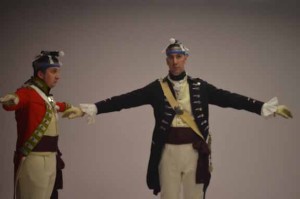 Toronto-based mobile content developer AWE, recently relied on iPi Motion Capture to create a virtual reality experience at the Fort York National Historic Site in Toronto. Using Google Cardboard, visitors to the nine-acre location in Toronto will be able to experience key battle scenes, military fortifications and the significant role that Fort York has played in the country’s history in a simulated, immersive 3D environment.
Toronto-based mobile content developer AWE, recently relied on iPi Motion Capture to create a virtual reality experience at the Fort York National Historic Site in Toronto. Using Google Cardboard, visitors to the nine-acre location in Toronto will be able to experience key battle scenes, military fortifications and the significant role that Fort York has played in the country’s history in a simulated, immersive 3D environment.
“Fort York is the largest historic site in Toronto and they wanted to create a dramatic visitor experience that spanned across the entire site, both indoors and out,” explained Srinivas Krishna, AWE’s CEO and the director of the project (produced through Krishna’s production company Divani Films, Toronto). “We created content that, when viewed on a mobile phone using Google Cardboard, immerses visitors inside a 360-degree environment that recreates historical events from different eras that occurred right where visitors are standing. It’s a fun and powerful experience.”
Perhaps most memorable is the pivotal role Fort York played during the War of 1812, when the U.S. naval ships attacked the British fort. To re-create that experience, along with several other noteworthy events that occurred at the site, Krishna designed a workflow that leaned heavily on iPi Motion Capture.
 Krishna explained that the project, which initially began three years ago, included creating animated model rigs for the multitude of characters that would be seen virtually. Built using Unity‘s 3D Game engine, the character models, as well as the environments (designed to look like Fort York at the time) were animated using Maya. That content was then composited with the motion-capture action sequences filmed using iPi Motion Capture, along with facial mocap data captured using Mixamo Face Plus.
Krishna explained that the project, which initially began three years ago, included creating animated model rigs for the multitude of characters that would be seen virtually. Built using Unity‘s 3D Game engine, the character models, as well as the environments (designed to look like Fort York at the time) were animated using Maya. That content was then composited with the motion-capture action sequences filmed using iPi Motion Capture, along with facial mocap data captured using Mixamo Face Plus.
“On the production side, we had a real problem because of the huge number of characters the client wanted represented,” Krishna said. “It became a challenge on many levels. We wondered, how are we going to create our 3D models and use motion capture in a cost effective way. iPi Soft proved great for this type of large-scale amount of footage on a modest budget. Markerless mocap is perfect for broad strokes, and as a filmmaker I found working with it to be a marvelous creative experience.”
While it would seem historical sites like Fort York are perfect for these types of virtual reality experiences, Krishna noted that the project was a bit of a risk given that when they started Google Cardboard wasn’t yet on anyone’s radar.
“We started developing this in 2012, which actually turned out to be good timing because we were able to think creatively and implement while at the same time the ecosystem for VR was developing,” Krishna explained. “We see this as a game-changer in this arena, and I think more historical sites around the world are going to be interested in creating these types of experiences for their visitors.”





